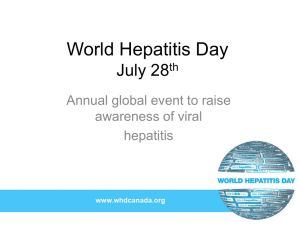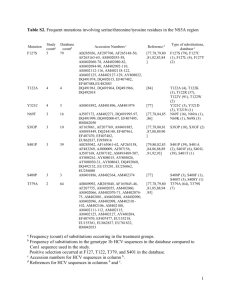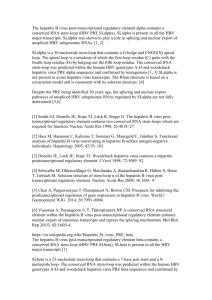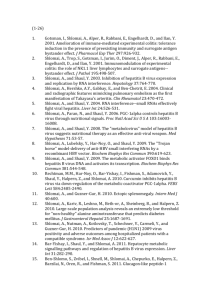Draft CA Dept of Health Care Services revised policy 5-21-15
advertisement
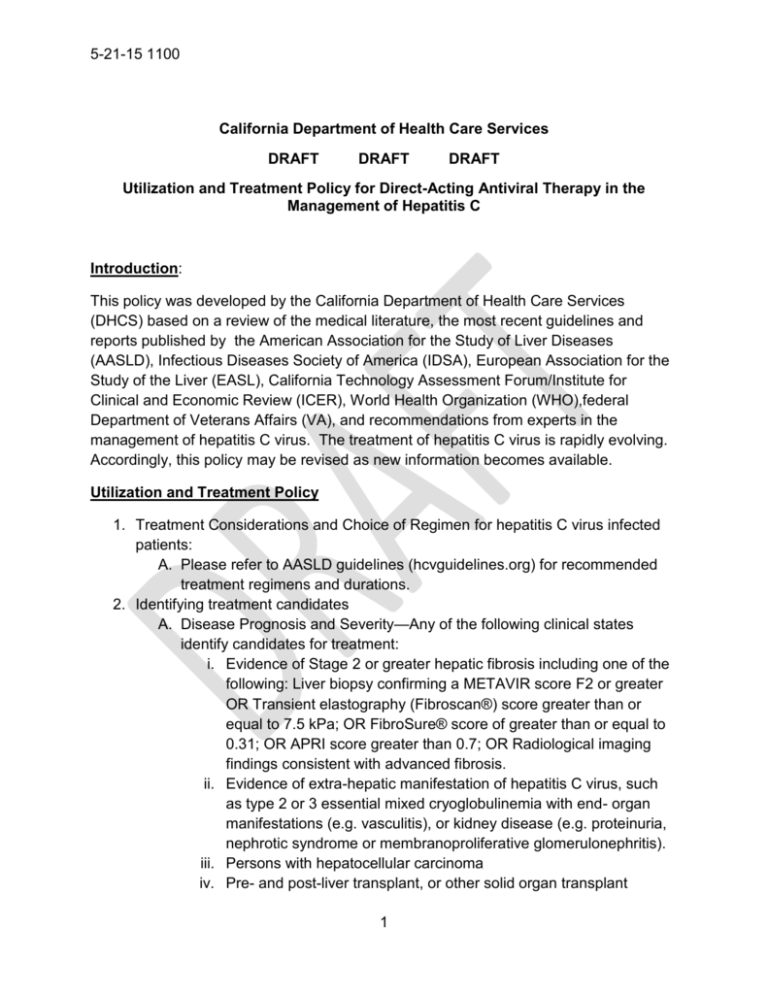
5-21-15 1100 California Department of Health Care Services DRAFT DRAFT DRAFT Utilization and Treatment Policy for Direct-Acting Antiviral Therapy in the Management of Hepatitis C Introduction: This policy was developed by the California Department of Health Care Services (DHCS) based on a review of the medical literature, the most recent guidelines and reports published by the American Association for the Study of Liver Diseases (AASLD), Infectious Diseases Society of America (IDSA), European Association for the Study of the Liver (EASL), California Technology Assessment Forum/Institute for Clinical and Economic Review (ICER), World Health Organization (WHO),federal Department of Veterans Affairs (VA), and recommendations from experts in the management of hepatitis C virus. The treatment of hepatitis C virus is rapidly evolving. Accordingly, this policy may be revised as new information becomes available. Utilization and Treatment Policy 1. Treatment Considerations and Choice of Regimen for hepatitis C virus infected patients: A. Please refer to AASLD guidelines (hcvguidelines.org) for recommended treatment regimens and durations. 2. Identifying treatment candidates A. Disease Prognosis and Severity—Any of the following clinical states identify candidates for treatment: i. Evidence of Stage 2 or greater hepatic fibrosis including one of the following: Liver biopsy confirming a METAVIR score F2 or greater OR Transient elastography (Fibroscan®) score greater than or equal to 7.5 kPa; OR FibroSure® score of greater than or equal to 0.31; OR APRI score greater than 0.7; OR Radiological imaging findings consistent with advanced fibrosis. ii. Evidence of extra-hepatic manifestation of hepatitis C virus, such as type 2 or 3 essential mixed cryoglobulinemia with end- organ manifestations (e.g. vasculitis), or kidney disease (e.g. proteinuria, nephrotic syndrome or membranoproliferative glomerulonephritis). iii. Persons with hepatocellular carcinoma iv. Pre- and post-liver transplant, or other solid organ transplant 1 5-21-15 1100 v. vi. vii. viii. ix. x. HIV-1 co-infection Hepatitis B co-infection Other coexistent liver disease (e.g. nonalcoholic steatohepatitis) Type 2 diabetes mellitus (insulin resistant) Porphyria cutanea tarda Debilitating fatigue impacting quality of life (e.g., secondary to extra-hepatic manifestations and/or liver disease) xi. Men who have sex with men with high-risk sexual practices xii. Active injection drug users (in treatment, see Section C.ii.) xiii. Persons on long-term hemodialysis xiv. Women of childbearing age who wish to get pregnant B. Patient Readiness and Adherence: i. Patients should be evaluated for readiness to initiate treatment. ii. Caution should be exercised with patients who have a history of treatment failure with prior hepatitis C treatment due to nonadherence with treatment regimen and appointments. iii. Patients should be educated regarding potential risks and benefits of hepatitis C virus therapy, as well as the potential for resistance and failed therapy if medication is not taken as prescribed. C. Substance Use: i. All patients should be evaluated for current alcohol and other substance use, with validated screening instruments such as AUDIT-C. Patients with a history of substance or alcohol use disorders and meet the disease prognosis and severity criteria may be considered for hepatitis C virus antiviral therapy on a case-bycase basis. There are no published data supporting a minimum length of abstinence as an inclusion criterion for hepatitis C virus antiviral treatment, while multiple studies show successful treatment of patients who have short durations of abstinence or infrequent use of alcohol. Thus, automatic disqualification of patients as treatment candidates based on length of abstinence is unwarranted and strongly discouraged. ii. The presence of current heavy alcohol use (>14 drinks per week for men or >7 drinks per week for women), binge alcohol use (>4 drinks per occasion at least once a month), or active injection drug use warrants referral to an addiction provider, where available, before treatment initiation. Patients with active substance or alcohol use disorders and meet the disease prognosis and severity criteria 2 5-21-15 1100 may be considered for therapy on a case-by-case basis, and care should be coordinated with substance use treatment providers. D. Mental Health: i. Hepatitis C virus-infected patients with severe mental health conditions (e.g., psychotic disorders, bipolar disorder, major depression, posttraumatic stress disorder), as documented by psychiatric evaluation, who are engaged in mental health treatment and meet the disease prognosis and severity criteria may be considered for therapy on a case-by-case basis. The use of interferon-containing regimens is associated with worsening of these conditions. Patients should be managed in collaboration with Mental Health providers to determine the risks versus benefits of treatment and potential treatment options. E. Age requirements: Treatment candidate must be 18 years of age or older. 3. Other considerations A. Quantity Limits: i. Prescription of direct-acting antiviral therapy will be dispensed in quantities up to 28 days at a time. B. Criteria for Reauthorization/Continuation of Therapy i. Initial authorization criteria have been met, and ii. Lost medications will not be replaced and may result in denial of treatment authorization. Replacement of stolen medications will require documentation (e.g., report to law enforcement authorities) and will be considered on a case-by-case basis. iii. Evidence of lack of adherence may result in denial of treatment reauthorization iv. Missed medical appointments related to the hepatitis C virus may result in denial of treatment authorization C. Laboratory Documentation Requirement: i. Documentation of baseline hepatitis C virus-RNA level ii. Documentation of hepatitis C virus Genotype iii. When applicable, relevant laboratory information in support of medical necessity for duration of therapy. D. Populations Unlikely to Benefit from Hepatitis C Virus Treatment: According to AASLD/IDSA hepatitis C virus Guidelines, “patients with limited life expectancy for whom hepatitis C virus therapy would not improve symptoms or prognosis do not require treatment. Chronic hepatitis C is associated with a wide range of comorbid conditions. Little 3 5-21-15 1100 evidence exists to support initiation of hepatitis C virus treatment in patients with limited life expectancy (less than 12 months) due to non– liver-related comorbid conditions. For these patients, the benefits of hepatitis C virus treatment are unlikely to be realized, and palliative care strategies should take precedence.” E. Retreatment: Retreatment will be considered where there is evidence that such retreatment will improve patient outcomes. Please refer to AASLD guidelines for recommended retreatment regimens (hcvguidelines.org). 4






